In the Tibetan tradition there are eight main types of Stupas (Chorten), each of those is related to a particular event in the life of Buddha Shakyamuni: Birth, Enlightenment, Turning of the Wheel of Dharma, Performance of miracles, Descent from Tushita Heaven, Reconciliation of the Sangha, Prolongation of life, Parinirvana.
Although the general structure of all the Stupas is the same (except Parinirvana Stupa), each Stupa has its own specific features – Stupas differ from one another by the exterior and shape of steps between the lion throne and vase (Parinirvana Stupa has no steps there at all).
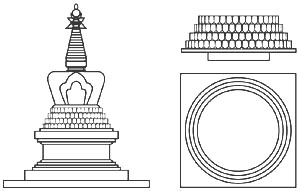 1. The Lotus Stupa
1. The Lotus Stupa
The Lotus Stupa is related to the birth of Buddha Shakyamuni. Right after birth Buddha took seven steps in each of the four directions - East, South, West and North. From Buddha's steps lotuses sprang in each direction.
The first Lotus Stupa was built in Lumbini, India - the birthplace of Buddha, during His lifetime. Steps above the lion throne are rounded and decorated with the lotus petals.
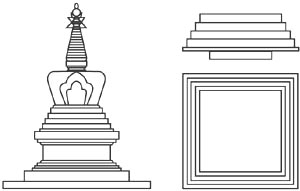
2. The Enlightenment Stupa
The Enlightenment Stupa symbolizes Buddha's attainment of enlightenment under the Bodhi tree. He realized that every living being can achieve Enlightenment.Also this type of Stupa known as a symbol of the victory over demon Mara, i.e. over ignorance and all other poisons or defilements of the mind. Enlightenment Stupa was built in Bodhgaya, India, where the Buddha achieved Enlightenment.
It is considered the main of the eight types of Stupas and represents the path to full Enlightenment. Steps above the lion throne are rectangular.
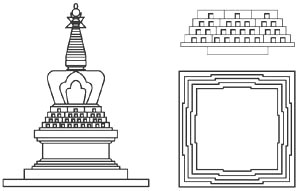 3. The Stupa of Turning the Wheel of Dharma
3. The Stupa of Turning the Wheel of Dharma
The Stupa of Turning the Wheel of Dharma or the Stupa of many favourable doors (gates). After attaining Enlightenment, the Buddha for the first time turned the Wheel of Dharma, i.e. delivered His first teachings. It took place in the Deer park, in Sarnath (Varanasi, India), where the Buddha gave the teaching of the Four Noble Truths.
Stairs above the lion throne are decorated with open doorways, symbolizing the opening of the doors of Dharma.
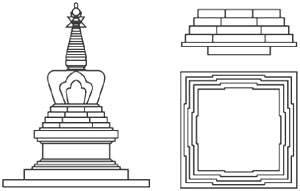 4. The Stupa of Great Miracles
4. The Stupa of Great Miracles
The Stupa of Great Miracles was built in Shravasti and commemorates various miracles displayed by the Buddha every day for fifteen days. With the help of miracles and intellectual disputes He defeated Maras (demons) and heretics, demonstrating the level of His attainment.
Central part of the steps above the lion throne is extended.
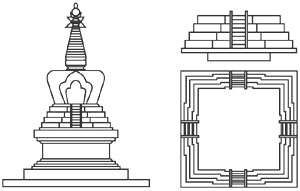 5. The Stupa of Descent from Tushita Heaven
5. The Stupa of Descent from Tushita Heaven
After the Buddha's motherpassed away, she was reborn in Tushita heaven. In gratitude for her kindness, the Buddha ascended to Tushita Heaven and gave her the Dharma Teaching. The Stupa of descent from Tushita Heaven symbolizes the Buddha’s return from the celestial realms in order to continue teaching the path to Awakening.
This Stupa originated in Sankashya (also called Sankassa or Sankasya), Uttar Pradesh state of India. Nowadays it is a desert place with the ruins of a Hindu temple. In spite of this, Sankashya is one of the eight places of pilgrimage for Dharma practitioners. In the central part of the steps, above the lion throne, there are stairs symbolizing Buddha’s descent from Tushita Heaven.
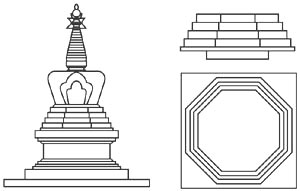 6. The Stupa of Reconciliation
6. The Stupa of Reconciliation
When envy and controversies appeared within the Sangha (community ofdisciples), the Buddha reunited the Sangha, and in order to commemorate this event the Stupa of Reconciliation was erected. Above the lion throne of the Stupa there are four octagonal steps with equal sides.
 7. The All-Victorious Stupa
7. The All-Victorious Stupa
After one of the Buddha's followers had beseeched him not to pass away Buddha prolonged His life by three months. Unlike other types of Stupas, the All-Victorious Stupa has only three rounded steps above the lion throne (instead of four rectangular).
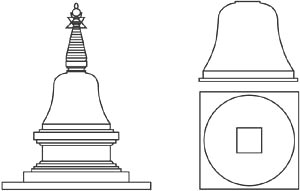 8. The Paranirvana Stupa
8. The Paranirvana Stupa
The Paranirvana Stupa is related to the Buddha's passing into Maha Parinirvana. It took place in the city of Kushinigar. Laying on his right side and being in a meditative state, Buddha preached his disciples about attaining Enlightenment, and then passed into Maha Parinirvana.
This Stupa by its shape differs from other Stupas. It has no steps above the lion throne, and right on the top of the throne there is a bell-shaped vase (wisdom symbol).
